How to Read Colors on the Flir One
Developing preferences for dissimilar thermal palettes allows confident controlling when it counts
Both formal law enforcement training and longstanding hunting practices assume there's a right and wrong way to practice things. Defined procedures assistance remove uncertainty and increase the chance of success, such as how to legally apprehend a suspect or safely handle a firearm. However, thermal imaging for police force enforcement and hunting is dynamic. Users translate thermal images differently and oftentimes must describe from personal feel to resolve specific situations. Understanding the strengths of dissimilar photographic camera settings is vital for quick, confident detection. When it comes to choosing the right thermal imaging palette—personal preference is king.
UNDERSTANDING THERMAL PALETTES
Thermal imaging cameras, riflescopes, and handheld optics all operate on the same basic premise. An onboard thermal sensor detects dissimilar amounts of rut energy, and then generates an image. While thermal images may sometimes look similar standard photographs, their vivid colors or contrasting grayscale details represent a very specific, very large data set. Understanding what these colors and shades represent—and learning how to best-leverage them in the field—allows police enforcement professionals, hunters, and outdoor enthusiasts to quickly detect suspects, targets, and objects of interest.
Like whatever digital image, thermal images are made up of pixels. The number of pixels in a thermal image is determined by the camera's resolution. College-resolution sensors generate images with a higher pixel-count and generally produce clearer results. In thermal imaging, each individual pixel represents a specific temperature data point. These data points are assigned a unique colour or shade based on their value, significant that as the thermal sensor detects changes in rut energy, it volition limited this change by adjusting the colour or shade of a pixel. These preset gradients—or thermal palettes—decide pixel appearance and help place unlike estrus sources throughout a scene.
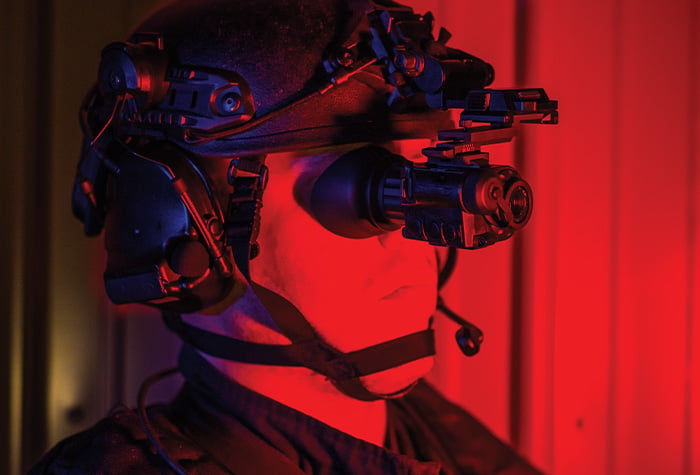
Almost law enforcement, search and rescue, and hunting applications focus on qualitative thermal imaging, which looks at the relative presence or absenteeism of heat in a scene —rather than focusing on numeric temperature values. Reliable, qualitative thermal imaging hinges on recognizing contrast between targets, objects of interest, and their surround. Detecting body heat is the priority and establishing thermal palette preferences allows users to confidently pinpoint heat sources. Familiarity with an optic and its imaging capability will be the differencemaker in quickly apprehending a doubtable, finding discarded bear witness, locating a lost hiker, or recovering downed game.
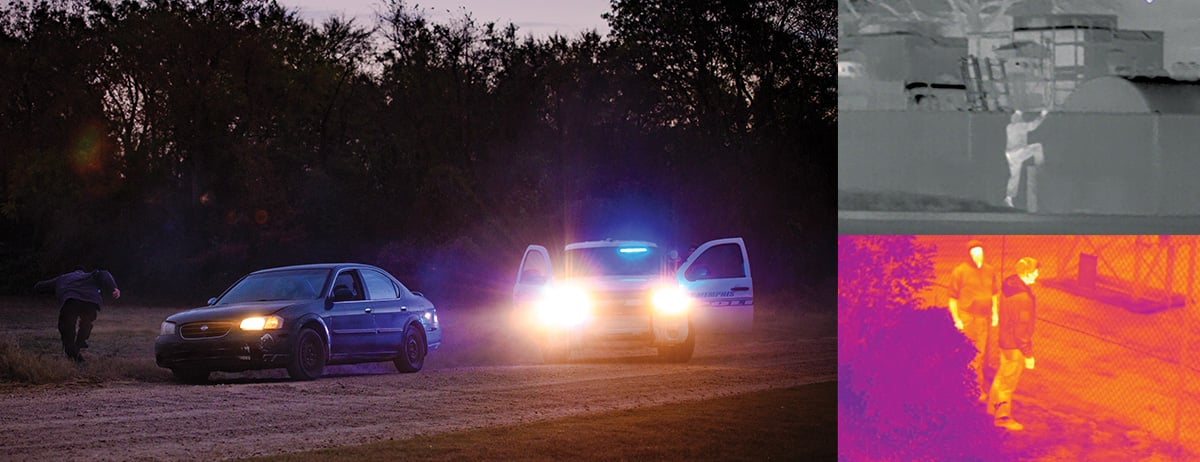
Thermal imagers provide superior tactical awareness in complete darkness and through glaring light
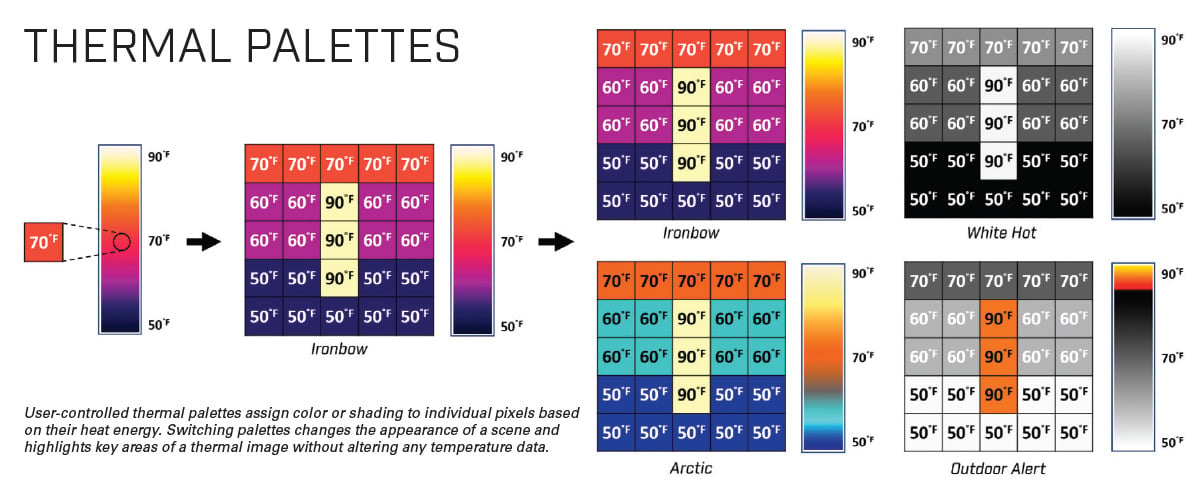
User-controlled thermal palettes assign colour or shading to individual pixels based on their oestrus free energy. Switching palettes changes the appearance of a scene and highlights key areas of a thermal epitome without altering any temperature information.
WEIGHING THE OPTIONS
FLIR thermal riflescopes and handheld optics offer multiple palettes for dissimilar personal preferences, environments, and situations.
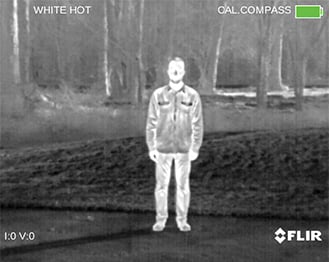
WHITE HOT:
The most commonly used palette, White Hot displays warmer objects in white and libation objects in black. Grayscale palettes offer simplicity for scenes with a wide temperature span and generate images with realistic details. The versatility of White Hot makes it highly-seasoned for utilize in shifting landscapes and urban areas.
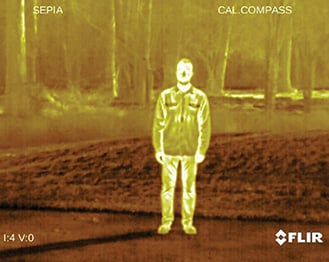
SEPIA:
The Sepia palette applies a warm, gold hue to the White Hot palette for reduced centre and mental fatigue. Ideal for instances of prolonged thermal surveillance or scouting, Sepia'southward narrow visual spectrum keeps users comfortable during long viewing periods.
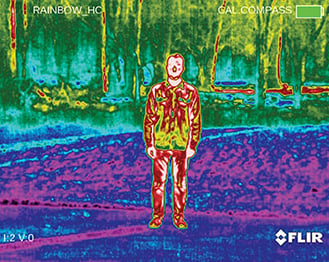
RAINBOW HC:
Using different colors to brandish minute temperature differences, Rainbow HC is best suited for scenes with minimal oestrus modify. Focusing on an area with similar heat energy allows the Rainbow HC to find objects and slight temperature changes despite low-contrast conditions.
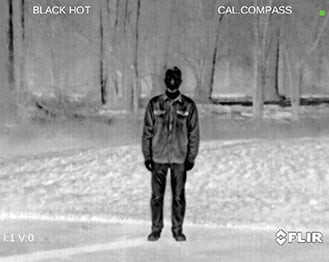
BLACK HOT:
Black Hot is the inverted version of White Hot, displaying warmer objects as black and cooler objects as white. A favorite among law enforcement and hunters, Black Hot displays body heat in a clear, lifelike prototype.
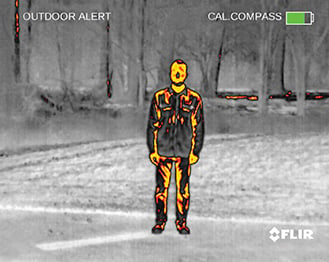
OUTDOOR Alarm:
Congenital on the trusted Black Hot slope, Outdoor Alert was designed for i purpose—apace detecting body estrus. Highlighting the warmest x% of a scene in a mix of vibrant oranges and yellows, Outdoor Alert is best suited for high-contrast environments and offers stellar nighttime torso heat detection.
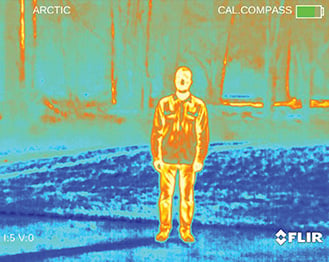
ARCTIC:
Identifying warm objects with a gold color and colder objects with shades of blueish, the Arctic palette mixes the simple coloring of Ironbow with the low-contrast performance of Rainbow HC. Differing colors quickly notice oestrus sources while darker shading picks out slight temperature changes.
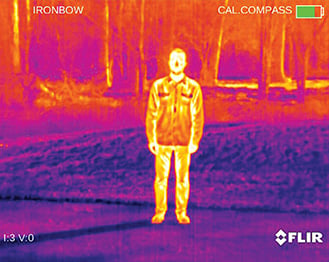
IRONBOW:
A general-purpose palette that apace identifies thermal anomalies and body oestrus, Ironbow uses color to show heat distribution and subtle details. Hot objects are shown in lighter, warm colors while colder objects are dark, cool colors.
CONCLUSION
Each user views and interprets thermal images differently. The simplicity of White Hot may non provide plenty detail for some, while the shifting colors of Ironbow may distract others. Thermal imagers are most constructive in the hands of users who tin can quickly interpret a scene, and hands-on experience with each available palette is the all-time mode to make confident, dissever-second decisions when it truly matters.
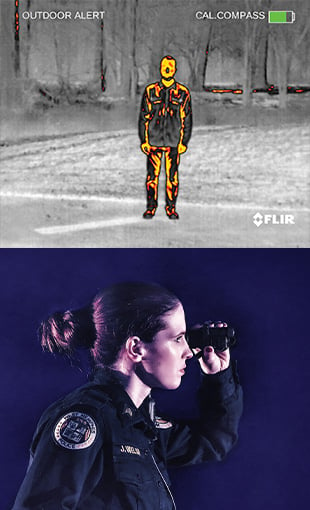
Elevation image - FLIR Outdoor Alert palette option
Bottom image - Thermal imaging monoculars like the FLIR Alienation® give constabulary enforcement professionals an advantage in the field
Source: https://www.flir.com/discover/ots/outdoor/your-perfect-palette/
0 Response to "How to Read Colors on the Flir One"
Post a Comment